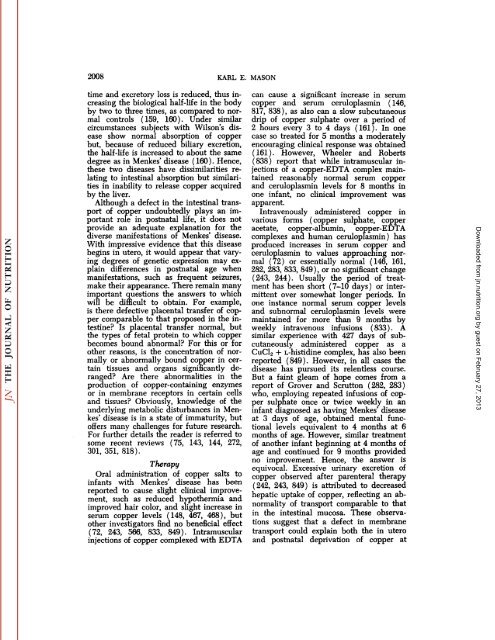conspectus of researchon copper metabolism and requirements
conspectus of researchon copper metabolism and requirements
conspectus of researchon copper metabolism and requirements
You also want an ePaper? Increase the reach of your titles
YUMPU automatically turns print PDFs into web optimized ePapers that Google loves.
2008 KARL E. MASON<br />
time <strong>and</strong> excretory loss is reduced, thus in<br />
creasing the biological half-life in the body<br />
by two to three times, as compared to nor<br />
mal controls (159, 160). Under similar<br />
circumstances subjects with Wilson's dis<br />
ease show normal absorption <strong>of</strong> <strong>copper</strong><br />
but, because <strong>of</strong> reduced biliary excretion,<br />
the half-life is increased to about the same<br />
degree as in Menkes' disease ( 160 ). Hence,<br />
these two diseases have dissimilarities re<br />
lating to intestinal absorption but similari<br />
ties in inability to release <strong>copper</strong> acquired<br />
by the liver.<br />
Although a defect in the intestinal trans<br />
port <strong>of</strong> <strong>copper</strong> undoubtedly plays an im<br />
portant role in postnatal life, it does not<br />
provide an adequate explanation for the<br />
diverse manifestations <strong>of</strong> Menkes' disease.<br />
With impressive evidence that this disease<br />
begins in utero, it would appear that vary<br />
ing degrees <strong>of</strong> genetic expression may ex<br />
plain differences in postnatal age when<br />
manifestations, such as frequent seizures,<br />
make their appearance. There remain many<br />
important questions the answers to which<br />
will be difficult to obtain. For example,<br />
is there defective placental transfer <strong>of</strong> cop<br />
per comparable to that proposed in the in<br />
testine? Is placental transfer normal, but<br />
the types <strong>of</strong> fetal protein to which <strong>copper</strong><br />
becomes bound abnormal? For this or for<br />
other reasons, is the concentration <strong>of</strong> nor<br />
mally or abnormally bound <strong>copper</strong> in cer<br />
tain tissues <strong>and</strong> organs significantly de<br />
ranged? Are there abnormalities in the<br />
production <strong>of</strong> <strong>copper</strong>-containing enzymes<br />
or in membrane receptors in certain cells<br />
<strong>and</strong> tissues? Obviously, knowledge <strong>of</strong> the<br />
underlying metabolic disturbances in Men<br />
kes' disease is in a state <strong>of</strong> immaturity, but<br />
<strong>of</strong>fers many challenges for future research.<br />
For further details the reader is referred to<br />
some recent reviews (75, 143, 144, 272,<br />
301, 351, 818).<br />
Therapy<br />
Oral administration <strong>of</strong> <strong>copper</strong> salts to<br />
infants with Menkes' disease has been<br />
reported to cause slight clinical improve<br />
ment, such as reduced hypothermia <strong>and</strong><br />
improved hair color, <strong>and</strong> slight increase in<br />
serum <strong>copper</strong> levels (148, 467, 468), but<br />
other investigators find no beneficial effect<br />
(72, 243, 566, 833, 849). Intramuscular<br />
injections <strong>of</strong> <strong>copper</strong> complexed with EDTA<br />
can cause a significant increase in serum<br />
<strong>copper</strong> <strong>and</strong> serum ceruloplasmin (146,<br />
817, 838), as also can a slow subcutaneous<br />
drip <strong>of</strong> <strong>copper</strong> sulphate over a period <strong>of</strong><br />
2 hours every 3 to 4 days (161). In one<br />
case so treated for 5 months a moderately<br />
encouraging clinical response was obtained<br />
( 161). However, Wheeler <strong>and</strong> Roberts<br />
(838) report that while intramuscular in<br />
jections <strong>of</strong> a <strong>copper</strong>-EDTA complex main<br />
tained reasonably normal serum <strong>copper</strong><br />
<strong>and</strong> ceruloplasmin levels for 8 months in<br />
one infant, no clinical improvement was<br />
apparent.<br />
Intravenously administered <strong>copper</strong> in<br />
various forms (<strong>copper</strong> sulphate, <strong>copper</strong><br />
acetate, <strong>copper</strong>-albumin, <strong>copper</strong>-EDTA<br />
complexes <strong>and</strong> human ceruloplasmin) has<br />
produced increases in serum <strong>copper</strong> <strong>and</strong><br />
ceruloplasmin to values approaching nor<br />
mal (72) or essentially normal (146, 161,<br />
282, 283, 833, 849), or no significant change<br />
(243, 244). Usually the period <strong>of</strong> treat<br />
ment has been short (7-10 days) or inter<br />
mittent over somewhat longer periods. In<br />
one instance normal serum <strong>copper</strong> levels<br />
<strong>and</strong> subnormal ceruloplasmin levels were<br />
maintained for more than 9 months by<br />
weekly intravenous infusions (833). A<br />
similar experience with 427 days <strong>of</strong> subcutaneously<br />
administered <strong>copper</strong> as a<br />
CuClo + L-histidine complex, has also been<br />
reported (849). However, in all cases the<br />
disease has pursued its relentless course.<br />
But a faint gleam <strong>of</strong> hope comes from a<br />
report <strong>of</strong> Grover <strong>and</strong> Scrutton (282, 283)<br />
who, employing repeated infusions <strong>of</strong> cop<br />
per sulphate once or twice weekly in an<br />
infant diagnosed as having Menkes' disease<br />
at 3 days <strong>of</strong> age, obtained mental func<br />
tional levels equivalent to 4 months at 6<br />
months <strong>of</strong> age. However, similar treatment<br />
<strong>of</strong> another infant beginning at 4 months <strong>of</strong><br />
age <strong>and</strong> continued for 9 months provided<br />
no improvement. Hence, the answer is<br />
equivocal. Excessive urinary excretion <strong>of</strong><br />
<strong>copper</strong> observed after parenteral therapy<br />
(242, 243, 849) is attributed to decreased<br />
hepatic uptake <strong>of</strong> <strong>copper</strong>, reflecting an ab<br />
normality <strong>of</strong> transport comparable to that<br />
in the intestinal mucosa. These observa<br />
tions suggest that a defect in membrane<br />
transport could explain both the in utero<br />
<strong>and</strong> postnatal deprivation <strong>of</strong> <strong>copper</strong> at<br />
Downloaded from<br />
jn.nutrition.org<br />
by guest on February 27, 2013
















